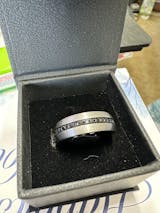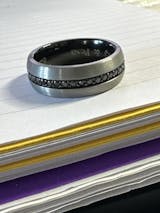- Is 14k gold worth buying?
14k gold offers a great balance between quality and durability. As pure gold (24k) is too soft for rings, jewelers generally use 10k, 14k, and 18k gold to make gold jewelry. 10k gold is cheaper and contains the least amount of gold at 41.7% but it is also a harder, more durable option. 18k gold contains 75% gold and as it is softer, it scratches more easily. 14k rings contain 58.5% gold and provide more durability compared to higher karats. This balance between price, quality, and slight resistance to wear (compared to the softer 18k gold) makes 14k gold jewelry incredibly popular in the US, with around 90% of gold wedding rings and engagement rings part of the 14k category.
- Can I shower with 14k gold?
While you can shower with 14k gold, it is better to remove gold jewelry before showering. The hot water coupled with any soap, shampoo, and shower gels will eventually affect the gold’s finish and polish. Rings will become dull and lose their shine, requiring polishing treatments.
- How much gold is in a 24-karat ring?
Gold purity is measured in karats and in parts of 24. A 24k gold ring will contain 24/24 parts gold, so it will be pure gold with a concentration of 99.9%. By comparison, an 18k gold ring will have 18 parts gold and 6 parts alloy, while a 14k ring will have 14 parts gold and 10 parts alloy.
- What is better 14k or 18k gold?
It depends on what you’re looking for. 14k gold contains less gold (14 parts gold to 6 parts alloy) but this composition also makes it more durable and harder than 18k gold. 18k gold rings are softer and can be scratched or damaged more easily. However they are also more valuable and a better investment.
- Will 18k gold turn skin green?
18k gold will not turn your skin green, as the amount of metals added to the gold to harden it is too low to cause a reaction to the skin. If an 18k gold ring does cause the skin to turn green, it may either contain too much copper or it may actually have a lower karat rating.
- Can I shower with 24k gold?
No, you should not shower with 24k gold. As 24k gold is 100% pure, it is soft and will scratch and bend much easier than 18k gold. This is why 24k jewelry is rare, as it is not practical to wear.
- Can you wear 14k gold everyday?
14k gold is the most popular gold for wedding bands in the US because it allows everyday wear and is significantly more practical than higher purity gold. Since it contains 14 parts gold to 10 parts alloy, 14k gold is more durable and strong than 18k gold. This doesn’t mean that 14 gold rings are scratch-resistant, simply that they will not be damaged as easily as an 18k ring would be.
- Is 14k gold real gold?
Yes, 14k gold is real gold. It contains 14 parts gold (58.5%) to 10 parts alloys. In the US, gold needs to be at least 10k to be considered real gold.
- Can I shower with 18k gold?
Showering with 18k gold will not damage gold jewelry, but it will remove its polish and shine. If you want to keep your gold jewelry looking like new for longer, you should remove it before taking a shower. This is especially true for softer gold of 18, 20, 22, and 24 karats.
- Why does my gold ring leave a green mark?
Gold jewelry is made with alloys in order to harden the metal. Pure gold of 24k is extremely soft and bends easily, so jewelers add alloys to gold to craft gold jewelry with lower karats. The lower the karat, the more alloy is added to gold. For example, a 10k gold ring will have 10 parts gold to 14 parts alloy, so it will be cheaper as well as more durable and more resistant to scratches compared to a 14k gold ring. However, the amount of alloy and the types of metal added to a 10k ring may cause an allergic reaction or turn the finger green. Nickel and copper are two of the metals that can cause this.
- What kind of gold can you shower with?
You can shower with 10k and 14k gold, although it’s safer to remove any gold jewelry before showering in order to maintain its polish and gleaming finish. It is not advisable to shower with 18k and 24k gold, as they are softer and prone to scratches, or with gold-plated jewelry, as the plating can easily wear off or even crack.
- Can you swim with 14k gold?
You should not swim with 14k gold jewelry because of two main reasons. Firstly, the salt in ocean water or the chlorine in swimming pools will damage the gold. Secondly, colder water will cause your fingers to shrink slightly, which increases the risk of losing a ring.
- Does rubbing a gold ring on your face show low iron?
No, rubbing a gold ring on the skin is not an accurate test for iron deficiency - this is an urban myth. While rubbing a gold ring on the face may leave a mark or a black line, this does not mean that someone is anemic. Gold can leave a mark if it reacts to makeup, lotions, or the skin’s chemistry. Rings with lower karats of 10k and 12k can also contain metals that react to the skin and leave a mark.
- How can I tell if my 24k gold is real?
If your ring does not have a hallmark that indicates the karats and/or its authenticity, you have a couple of options to discover if it is real 24k gold.
Pure gold will never rust, tarnish, or leave marks on the skin. It should also never have any discolorations. As gold does not react to vinegar, you can use white vinegar to test your ring and see if it changes color. After leaving the jewelry in vinegar for around 10 minutes, a 24k ring will remain the same, while a fake gold ring will have black or discolored markings.
You can also easily scratch or bend a 24k gold ring, as pure gold is soft, although this method will leave a mark or damage the ring.
Buying a testing kit with nitric acid can help you find out if your 24k gold ring is real. However, this method may cause some damage to pure gold jewelry, so it is better to take the ring to a jeweler who can perform the test safely.
A strong magnet should never attract a 24k gold ring, as pure gold is not magnetic. This method is not 100% accurate, as some fake gold rings can be made with a non-magnetic materials and a gold plating.
Dropping a gold ring inside a jug of water is an easy (though not 100% accurate) way to see if it’s genuine. As pure gold is dense and the ring should sink. If it sinks slowly or even floats, the ring is definitely not 24k gold.
- Can you bend gold with your hands?
Gold’s malleability depends on its purity. For example, you can easily bend a 24k gold ring as it is 99.9% pure gold. Lower karats contain alloys that harden the gold and make it more suitable for jewelry manufacturing.10k and 14k gold rings will contain a larger quantity of alloys, which will make them harder to bend compared to an 18k gold ring.
- Does vinegar harm gold?
No, vinegar does not harm gold. It may however damage precious stones set in a gold band, so keep that it mind if you want to clean your gold ring with a vinegar solution.
- Does gold turn black when burned?
Pure gold will not turn black when burned. If a ring has fewer than 18 karats and is made with copper, iron, or brass alloys, it can turn black as the metals react to the heat.
- Which metal is more expensive than gold?
While traditionally platinum has been the one precious metal more expensive than gold, palladium has surpassed it as of 2019. Due to the rarity of palladium and its use in cleaner car exhaust systems, palladium is now more expensive than platinum, gold, and silver – the four main precious metals.
- Why is my gold ring turning black?
If a gold ring is made with a lower karat, it may contain different metals that react to certain chemicals. For example, a 10k gold ring will contain 41.7% gold, with the rest made up of different metals. Copper, nickel, iron, and other elements can make a ring turn black if exposed to chlorine or bleach.
- Can gold be destroyed by fire?
No, real gold can not be destroyed by fire, but it will melt at a temperature of 1947.52 °F
- Is gold heavier than tungsten?
Gold and tungsten have a similar density, of 19.3g/cm2 to 19.28g/cm2. This is why tungsten is sometimes used to make fake gold, as the two metals feel so similar in weight.
- Is white gold real gold?
Yes, white gold is real gold. It is an alloy made with yellow gold and a white metal like silver, zinc, nickel, or palladium. White gold also features a rhodium plating which actually gives it the bright silver color and lustrous finish. When the rhodium plating wears off, a white gold ring turns yellow.
- Why is Indian gold so yellow?
In India, 22k gold is more commonly used in the jewelry industry. As 22k gold contains 22 parts pure gold and only 2 parts alloys, it has a rich golden color.
- Which gold is most expensive?
24k gold is the most expensive, as it contains 99.9% gold. However, this is also the softest gold and it is not practical to wear every day.
- What is the hardest karat gold?
The hardest gold is 10 karats. As it contains 10 parts gold and 14 parts alloys, it is significantly harder and more resistant to damage than 24k gold, which is soft enough to bend by hand. As a comparison, on the Mohs hardness scale 24k gold has a rating of 2.5, 18k gold of 2.75, 14k gold of 3-4, while 10k gold has a hardness of 4. These measurements may vary slightly, depending on the types of metals added to the gold.
- Is 10k gold worth buying?
It depends on what you’re looking for. 10k gold is the most affordable option as it contains less gold than 14k and 18k gold. It is also the most durable and hard, as the metal alloys harden the gold and make it less likely to scratch and bend compared to higher karats. However, 10k jewelry also has some downsides. Apart from not being as valuable, it can also contain metals that may cause allergic reactions, turn the skin green, or make the ring turn black when exposed to fire, bleach, chlorine, and other elements that would otherwise not damage 18k or 24k gold.
- Is Silver stronger than white gold?
White gold is generally stronger than silver, but this also depends on white gold’s karats. Sterling silver is a relatively soft metal and can be damaged easier than white gold. It will also tarnish over time and will require maintenance. However, white gold rings have a rhodium plating that will wear off and require re-plating.
Read about:


